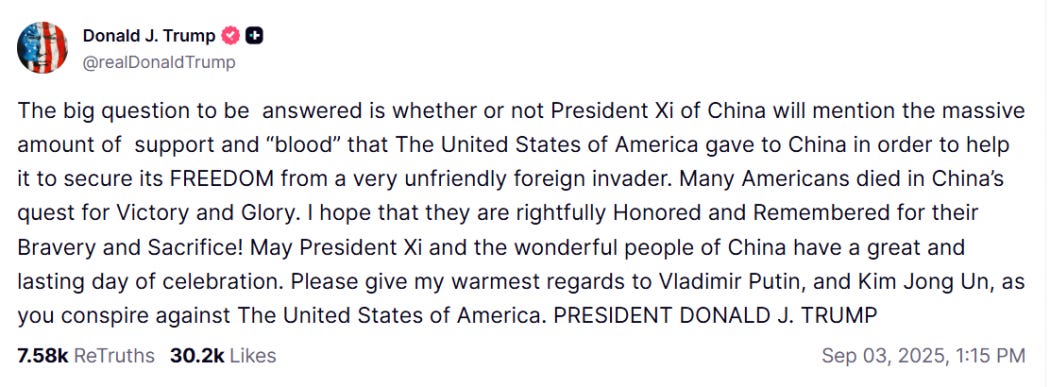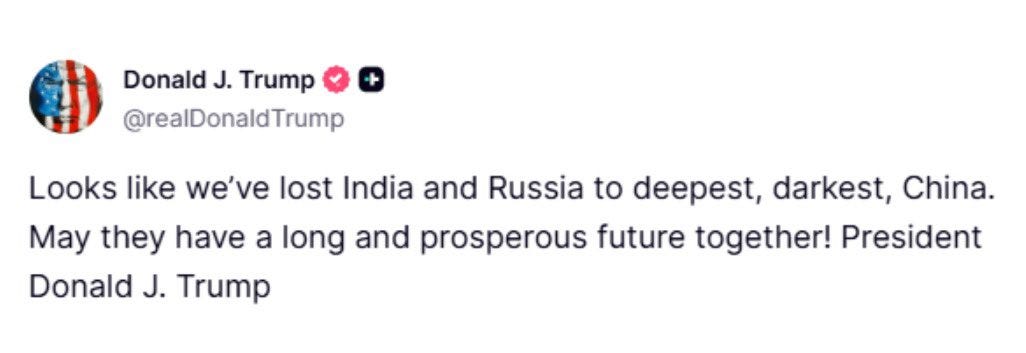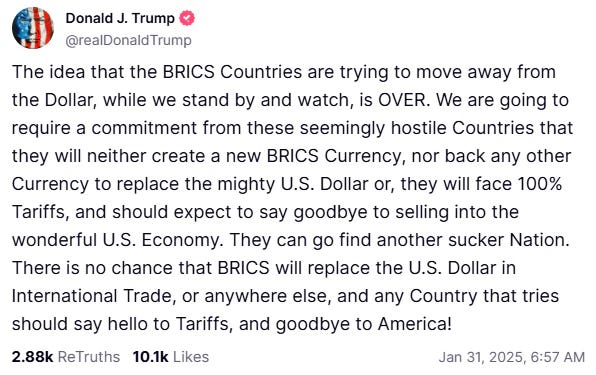Trump’s Boomerang Effect
Tariffs and Sanctions Meant to Divide Are Binding BRICS Tighter — and Accelerating De-Dollarization
Just recently it seems, Donald Trump was rolling out the red carpet for Indian Prime Minister Narendra Modi and extending olive branches toward Moscow. Not just through back channels either—earlier this year he even invited Putin to a summit in Alaska, a symbolic gesture to bring Russia in from the cold.
Note: Russia was also notably excluded from Trump’s “Liberty Day” tariffs in July, a set of sweeping duties aimed at allies and rivals alike.
The strategy seemed clear: keep key BRICS members close to prevent them from drifting fully into China’s orbit.
But that approach now seems pretty much dead.
Last week, as Xi, Putin, Modi, and other leaders stood together at a massive military parade in Beijing, Trump fired off a post on Truth Social—calling it a conspiracy against the United States:
And just two days later, he followed it up with a post bemoaning the loss of India and Russia to China:
Now, words are one thing—and yes, this is Trump we’re talking about. But they came backed by action: just weeks earlier, India was slapped with 50% tariffs for the crime of buying Russian oil. Brazil got the same treatment for putting former president Jair Bolsonaro on trial.
None of this is new, of course. Washington has made an art form out of weaponizing its economy—and the dollar—against anyone who steps out of line. Trump, in particular, has made tariffs central to his playbook, both in his first presidency and now in what we have dubbed Trump’s Reset.
Note: Until recently China—the main BRICS heavyweight—faced tariffs as high as 145% before new deals brought them down.
What’s new now is that Trump seems to be picking a fight with the entire BRICS bloc—without offering carrots to some while hitting others, as he’s usually done with China. And that may be biting off more than he can chew.
Not Just Any Bunch of Countries
A couple of facts you need to know about BRICS…
BRICS collectively hold close to 40% of the world’s GDP, surpassing the 30% held by the G7 countries.
BRICS represent nearly half of the world's population.
BRICS nations produce about 43% of global crude oil output.
It's fair to say that BRICS isn’t just any bunch of countries.
In fact, the membership roster reads like a who’s who of global commodity producers and rising giants: Brazil, Russia, India, China, and South Africa—now joined by Egypt, Ethiopia, Iran, and the UAE. Indonesia signed on in January.
Each brings something crucial to the table. China provides manufacturing muscle and technology. Russia brings energy and raw materials. India offers a massive consumer market and tech services. Brazil controls agricultural commodities. The Middle Eastern members add oil wealth and financial hubs.
Stitch these together, and you get an economic ecosystem that doesn’t need Washington’s permission to function. That’s a direct problem for the U.S. government whose global influence rests on the almighty dollar.
The Dollar’s Fading Grip
But here’s the rub. The dollar’s dominance isn’t what it once was. Global central banks now hold about 58% of their reserves in dollars, down from over 70% two decades ago. Just take a look at the next chart.
Like it or not, the trend line is clear—the world is de-dollarizing.
Worse still, inside BRICS, things are moving at double speed. These countries have really been working overtime to break free from dollar dependence.
China launched its Cross-Border Interbank Payment System back in 2015. Russia began building its own financial messaging network, SPFS, after the 2014 Crimea sanctions scare (today comprising over 150 participants across more than 20 countries).
Now both countries are working together to integrate these two systems across the entire bloc as part of their efforts to create an alternative to SWIFT, the New York–based backbone for global bank-to-bank payments.
If they succeed, payments for oil, gas, and other natural resources between China, Russia, Saudi Arabia, and the rest of the bloc won’t need to touch the dollar. That would be a body blow to the petrodollar, the cornerstone of America’s monetary hegemony since the 1970s.
But even before full integration, the move away from the dollar is already racing ahead.
Take China’s overseas transactions: the yuan has recently overtaken the dollar for the first time ever. Back in 2020, more than half of China’s cross-border trades were still settled in dollars. By 2025, over half are now done in yuan.
It’s hard to overstate what a turning point this is—for decades, the dollar was the unquestioned medium of China’s global commerce, and now—suddenly—it seems to be on borrowed time.
The same trend is visible within BRICS trade, which reached nearly $700 billion in 2024, up from around $100 billion in 2008. A growing share of that commerce bypasses the dollar altogether. DBS, Southeast Asia’s largest lender, for instance, recently reported a 30% jump in yuan settlement flows—especially in transactions linking China with Latin America and the Middle East.
And you can see it on the ground, too. In places like Brazil, Chinese BYD electric vehicles now crowd factory lots once dominated by Ford—with payment agreements in local currencies.
The Boomerang
Unlike his predecessor, Trump clearly understands this is a problem for the U.S. The trouble is that his chosen cure looks more like poison. His approach is pure gangster—tariffs as bludgeon, threats as persuasion. This post on Truth Social back in January made the point unmistakable:
Now, I enjoy a bit of Trump bravado as much as anyone. But here it’s exactly the wrong prescription. And you know why? Because at the end of the day, these countries joined forces precisely so they wouldn’t be picked off and bullied into submission one by one. That’s the whole point of BRICS.
If U.S. pressure was the glue that bound them together, then more pressure will only harden that bond. It’s the boomerang effect in action.
Note: In psychology, the boomerang effect describes what happens when attempts to persuade someone backfire—instead of changing their beliefs or behavior, the pressure only reinforces them.
In fact, just yesterday—September 8, 2025—Brazil’s President Luiz Inacio Lula da Silva used a virtual BRICS summit to call for unity, urging the bloc to stand up to unilateralism and push for a “fairer world order.”
What it all adds up to is this….
Every 50% tariff WILL make dollar alternatives more attractive.
Every threat WILL push BRICS members closer together.
Every sanctions regime WILL prove why they need payment systems that don’t run through New York.
You can take that to the bank.
The irony is that Trump’s sarcastic quips about “losing” India and Russia to China are starting to look less like jokes and more like forecasts. Treat countries like enemies long enough, and eventually they’ll start acting like it.
Regards,
Lau Vegys






Trump is way out of his depth and with idiots like Navarro advising him things will get worse quickly.
Excellent job of pointing out the inconsistencies and yet as, was it?, Emerson said: A foolish consistency is the hobgoblin of little minds. Not that I'm saying Trump intends these inconsistent positioning, just that he's doing his thing. The folks around him are trying to make it fit a broader trajectory and serve a purpose that if not helpful will at least lay open new opportunities for recovery after the Fourth Turning. We're all in this together. Pray for the best.